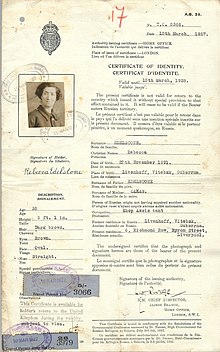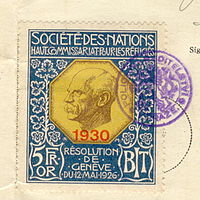Nansen passport
| Nansen passport | |
|---|---|
 The front cover of a Nansen passport (green stripe) | |
| Type | Passport |
| Issued by | League of Nations |
| First issued | 1922 |
| Purpose | Identification |
| Eligibility | Stateless refugees |
| Expiration | 1938 |
Nansen passports, officially stateless persons passports, were internationally recognized refugee travel documents from 1922 to 1938, first issued by the League of Nations to stateless refugees.[1] They quickly became known as "Nansen passports" for their promoter, the statesman and polar explorer Fridtjof Nansen.
History
The first Nansen passports were issued following an international agreement reached at the Intergovernmental Conference on Identity Certificates for Russian Refugees, convened by Fridtjof Nansen in Geneva from July 3, 1922 to July 5, 1922 in his role as High Commissioner for Refugees for the League of Nations.[2] By 1942, they were honoured by governments in 52 countries. Approximately 450,000 Nansen passports were provided[3] to stateless people and refugees who needed travel documents but could not obtain one from a national authority.
The Nansen passport was originally provided to refugees from the Russian civil war. It is estimated that about 800,000 Russian refugees had become stateless when Lenin revoked citizenship for all Russian expatriates in 1921.[4]
In 1933, the arrangement was broadened to also include Armenian, Assyrian, and Turkish refugees.
Following Nansen's death in 1930, the passport was handled by the Nansen International Office for Refugees within the League of Nations. At that point the passport no longer included a reference to the 1922 conference, but were issued in the name of the League. The office was closed in 1938; passports were thereafter issued by a new agency, the Office of the High Commissioner for Refugees in London.[5]


-
Nansen passport cover,
Police office, Prague, 1930 -
A stamp in a Nansen passport,
Nansen International Office for Refugees -
Memorial Plaque, outside wall,
City Hall, Oslo, Norway
Nobel Peace Prize
The Nansen International Office for Refugees was awarded the 1938 Nobel Peace Prize for its efforts to establish the Nansen passports.[6]
Today
While Nansen passports are no longer issued, existing national and supranational authorities, including the United Nations, issue travel documents for stateless people and refugees, including certificates of identity (or "alien's passports") and refugee travel documents.
Notable holders
- Robert Capa
- Marc Chagall
- Alexander Galich
- Alexander Grothendieck[7]
- G. I. Gurdjieff
- Anatol Heintz
- Vladimir Nabokov
- Aristotle Onassis
- Anna Pavlova
- Jadwiga Piłsudska
- Sergey Rakhmaninov
- Rabbi Menachem Mendel Schneerson
- Otto Skorzeny[citation needed]
- Igor Stravinsky[8]
- Dries Riphagen
References
- ^ "The Little-Known Passport That Protected 450,000 Refugees" Atlas Obscura, Retrieved 10 October 2017
- ^ "Documents from the League of Nations Archives" (PDF). Refugee Survey Quarterly. 22 (1): 71–73. 2003. doi:10.1093/rsq/22.1.71. Retrieved June 25, 2014.
- ^ Nansen-pass Store Norske Leksikon, retrieved December 11, 2012
- ^ Arkivverket.no (in Norwegian), retrieved December 11, 2012
- ^ The Nansen Office Arkivverket. Retrieved 2 December 2014
- ^ Fridtjof Nansen, Nobelprize.org, 1922. Retrieved 22 February 2011.
- ^
Mumford, David (2015). "(Obituary) Alexander Grothendieck (1928-2014) Mathematician who rebuilt algebraic geometry". Retrieved 2015-10-14.
{{cite journal}}: Cite journal requires|journal=(help) - ^ Nansenkontoret Arkivverket.no (in Norwegian), retrieved December 11, 2012



